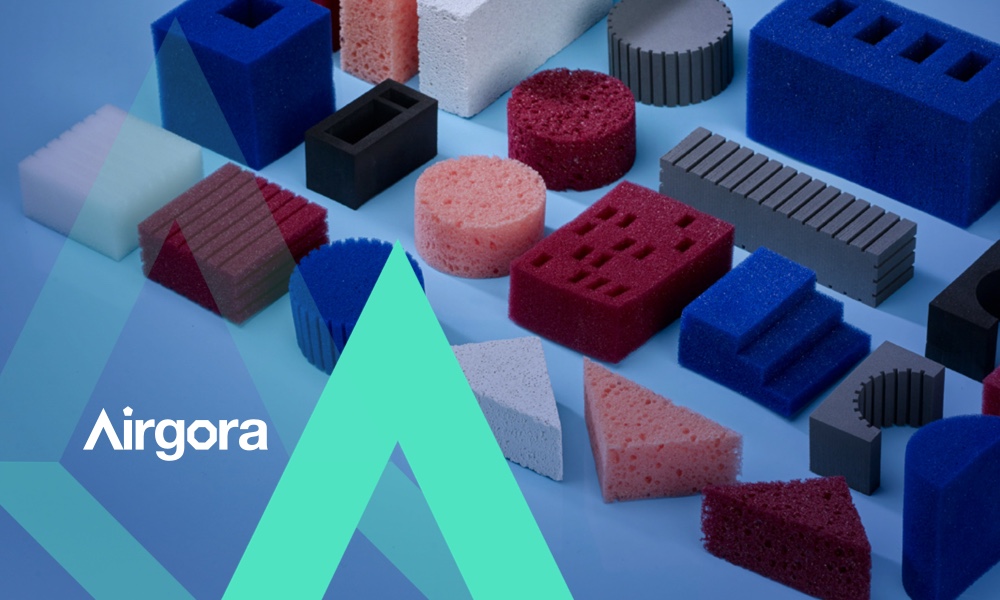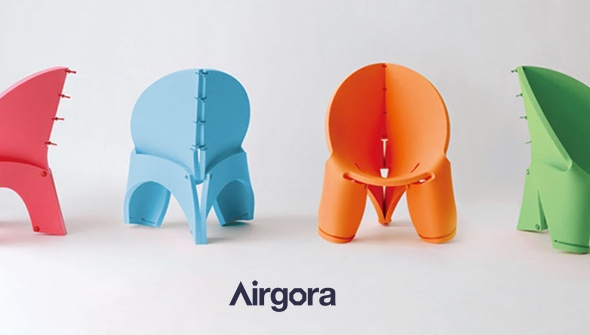Discover Airgora: A Platform for Industrial and Product Design
Posted By Hannah Bensoussan on Sep 28, 2016 | 0 comments
One of the aspects of our field, 3D design and 3D printing, is industrial design. Industrial designers create products we use in all aspect of our life. From the chairs you sit on, the laptop you use to work, the cup you use to drink to the LED TV you use to watch Netflix. Industrial designers create functional and beautiful physical products that solve a specific problem or need. Industrial designers work spans across many different industries including consumer, healthcare, manufacturing, furniture, etc.
Yet today, there’s an issue in matching offer and demand for industrial design services. The process of seeking the right designers for many hardware companies is convoluted and designers are in need for an effective and transparent way to promote their design services.
Airgora, founded by Leona Hu Hudelson, is an online platform whose ambition is to fix this mismatching issue. Currently in Beta, it intends to become the best online community for physical product design and the best resource for hardware companies to look for designers.
We asked Leona to tell us about industrial designing and designing for 3D printing.
1. About Leona Hu Hudelson and Airgora
Sculpteo: What is Airgora?
Leona Hu Hudelson: Airgora is an online community and marketplace for Industrial / Product / Furniture Designers. It’s a platform which helps designers of physical products to showcase their work directly to people who are looking for them, in order to promote and sell their products and services.
S: Where did the idea come from? Which problem does it aim to fix?
L.H: I founded Airgora early this year after leading and designing web experience projects for the manufacturing and product design industries at Autodesk. Throughout my design career, I have worked with numerous industrial designers and firms. I saw a visible problem for designers to promote their design services to hardware companies and consumers. And on the other hand, I have been constantly asked by many entrepreneur friends who founded their hardware startups to recommend designers and firms. Many of these entrepreneurs come from business or engineering backgrounds, they relied on manufacturing consultants or their connections to identify designers. At the same time, many less notable industrial design firms or designers can only rely on self-promotion at trade shows, design competitions or cold-calls to get contracts.
S: Can you tell me about your background? About your experience as a designer?
L.H: I am an architect by training and digital product designer by trade. During my architecture school, I was very fascinated by the physical product design process and digital fabrication, and I spent a lot of time staying in the rapid prototyping shop using laser cutters, CNCs and 3D printers. I pursued my early passion in software development career after school. After working for many large tech companies and small startups, I have witnessed that designers’ roles and responsibilities became more prominent in the product development cycle, especially in the Silicon Valley which was previously predominant in engineering. Whether it’s in software or hardware, designers are driving the creative forces of technological innovation. Good design makes good products, good design increases the product value.
S: At which stage of your development are you?
L.H: We launched the Public-Beta 1.0 in June, and we are working hard on launching the Public Beta 2.0 in October. (You can sign up for our early 2.0 access at airgora.com)
S: How is the Beta offer going? Who has signed up so far?
L.H: In Public-Beta 1.0, which we launched three months ago, we featured many internationally renowned designers and design firms including Satoshi Itasaka, De Intuitiefabriek, Box Clever, Matter Inc. and Lunar. We also have a group of very talented designers signed up, and are experiencing a high growth of this user group.
S: Which extra features are you planning for the Beta 2.0?
L.H: Our upcoming Public-Beta 2.0 will include the full features for designers and design teams to post products, get contact by clients and customers. (You can get an early access invite by signing up on airgora.com).
We will be also be announcing partnerships with software, manufacturing, prototyping, and supply chain services and products to provide Airgora users discounted deals and special accesses.
S: Can you explain in details how the platform works and what it provides?
L.H: The platform lets designers and design teams share and showcase their work. Everyone can sign up, browse, and favorite products posted in the community. However, to maintain the highest quality for the community, only users who get an invitation can post their products and services. The invitation system allows us to select notable designers and design firms to peer curate the community.
Pro and Team users have special badges for hire and can easily connect with potential clients.
Pro and Team users get free and discounted products and services from our partners from software, prototyping, manufacturing and supply chain services.
Designers and design teams get featured in our online and print magazine, Showcase.
S: How much does the access to your services cost?
L.H: It’s free to sign up for everyone. In order to retain the quality of our community, we are giving invitations to influential designers to help us expand and curate who can post products. Also, our Pro account cost $30 per year and Team account cost only $100 per year. By paying the price of a cup of coffee per month, designers can get offers and deals from our partners that are worth $1000+, and most importantly, they are exposed to potential clients right away. For Team accounts, we are helping design teams to get hire or recruit designers in addition to all the benefit the Pro account users can get.
S: Which features do you hope to add to the next versions of the platform?
L.H: In our future versions, we are hoping to integrate API and features that allow users to list and showcase their 3D model files directly on the browser.
We are building Airgora as the best online community for physical product design and the best resource for hardware companies to look for designers.
(Read about Sculpteo’s API options here.)
2. Industrial design and 3D printing: advantages, experiences, and tips for your business
S: Which qualities do industrial companies look for in industrial designers?
L.H: Every company has different design requirements based the the company scale, project need, budget and styles. For instance, large and notable companies such as Jawbone would hire more experienced Industrial Designers to work on products adopted by millions of users. Smaller startups might have much less budget, quicker turnarounds and often times, all they need is a designer who can design and prototype quickly so they can test out the market. Overall, because of the surging Internet of Things and connected devices markets, Industrial Designers’ roles are becoming increasingly critical to the success of a product. A successful designer understands how to design around the technical, financial and manufacturing constraints, they also master the skills of creating an emotional experience for users. We all adore Apple products because the moment we pick up an iPhone, we all have a positive emotional response to this beautiful and meticulously crafted object that fits perfectly in our hand.
S: How do you promote and showcase these qualities?
L.H: Airgora Public – Beta 2.0 will help hiring companies and customers to filter through designers and design companies by their locations, skills, experience and most importantly, their design sensibility, which often comes from the designer’s styles and ways of working on a product. The filter system is extremely transparent and easy to use.
S: Which 3D printing skills should an industrial designer have, and how does he or she acquire them?
L.H: 3D printing has become one of the most integral technologies for rapid prototyping and manufacturing among the design professionals and academics. It helps designers to achieve many impossible design forms aesthetically and functionally. When it comes to designing for 3D printing, the 3D modeling part is critical. Designers need to be mindful on the real world physics of the objects they design, and many 3D modeling software are making the process of creating, assessing and exporting model files to 3D printers easier. For instance, many designers are experts of creating beautiful 3D models or renderings, but they might not be skilled to create production-ready, watertight model file to communicate with a specific 3D printer. The learning curve of 3D printing is still steep for professional designers, and it’s also costly and time consuming to own an advanced printer or train employees to use the printers. That’s why Airgora is partnering up with the additive manufacturing service company Sculpteo to give designers and firms an easier and more affordable access to on demand 3D printing services.
(To learn more about 3D designing, you can visit our learning center, our tutorials about preparing a file for 3D printing, and our free ebooks)
S: As an industrial designer, do you use online 3D printing services like Sculpteo?
L.H: Yes. Cost, accessibility and training are the three major constraints for designers and design firms to own high performance or industrial grade 3D printers. Hence on-demand services like Sculpteo provide designers a simple tool to upload and 3D print a design, and a transparent avenue for cost effective batched production and prototyping. With the professional services and production support from Sculpteo, designers can spend more time on refining the design.
S: Which place will you give to 3D printing on your platform?
L.H: Soon in the future, we are hoping to implement Sculpteo web API for designers to upload their 3D model seamlessly directly from Airgora platform.
S: What about laser cutting?
L.H: Laser cutting absolutely has its place too! Laser cutting technology is still a very relevant prototyping and production tool for designers. It’s a good thing that Sculpteo is making laser cutting available online as a service, like 3D printing.
S: Are there other digital manufacturing techniques you would like to see go online, as services?
L.H: I’d love to see that in the future that the production software can be unified between the 3D model source files and 3D printers, or CNCs, so designers can spend more time to create products instead of preparing CAD files for productions.
S: An advice for an industrial designer who wants to learn to make the most of 3D printing?
L.H: Model wisely while choosing 3D printing as a prototyping or manufacturing method. I have seen designers blow $2000 on printing a small prototype because they did not set the 3D file correctly. There are many available learning resources on this topic, including Sculpteo’s learning platform.
S: An advice for an industrial company who’s looking to make the most of 3D printing?
L.H: Always consult with manufacturing and design experts on whether 3D printing is the right answer to the product.
Whether you are a designer looking for a way to promote your designs, or an industrial company looking for talented 3D designers, we invite you to check out Airgora, and follow their evolution as they improve their services and integrate APIs and partners discounts.


 Connect with Google
Connect with Google Connect with Facebook
Connect with Facebook

